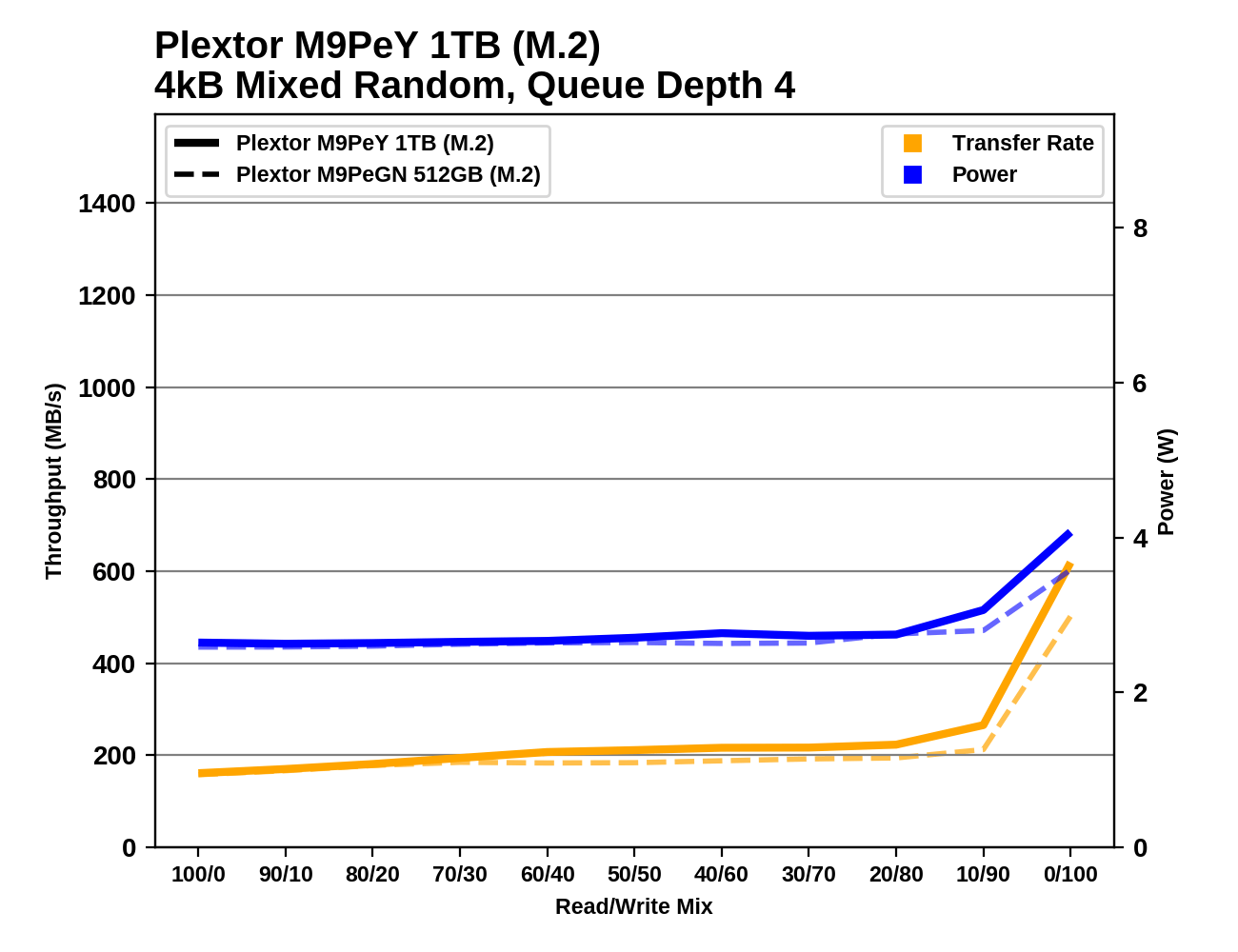The Plextor M9Pe NVMe SSD Review: Teaching An Old Chip New Tricks
by Billy Tallis on May 24, 2018 1:00 PM ESTMixed Random Performance
Our test of mixed random reads and writes covers mixes varying from pure reads to pure writes at 10% increments. Each mix is tested for up to 1 minute or 32GB of data transferred. The test is conducted with a queue depth of 4, and is limited to a 64GB span of the drive. In between each mix, the drive is given idle time of up to one minute so that the overall duty cycle is 50%.

The performance of the Plextor M9Pe on the mixed random I/O test is better than the SATA drive and the low-end NVMe drive, but is otherwise disappointing and not competitive with the other high-end SSDs or even the preceding M8Pe.
 |
|||||||||
| Power Efficiency in MB/s/W | Average Power in W | ||||||||
Power efficiency from the M9Pe on the mixed random I/O test is poor, but similar to the earlier Plextor drives. The drives with newer controllers not only perform better, but most also require much less power.
 |
|||||||||
The two capacities of the Plextor M9Pe show very similar performance scaling across the random I/O test, with very slow performance growth as the proportion of writes increases, until near the end of the test when there are enough writes to perform effective caching and coalescing. Most drives show much more substantial performance growth during the first 80% of the test.
Mixed Sequential Performance
Our test of mixed sequential reads and writes differs from the mixed random I/O test by performing 128kB sequential accesses rather than 4kB accesses at random locations, and the sequential test is conducted at queue depth 1. The range of mixes tested is the same, and the timing and limits on data transfers are also the same as above.

The mixed sequential I/O test again puts the M9Pe in the situation of being the slowest drive that's trying to be high-end. It does outperform the SATA drive and the MyDigitalSSD SBX, but drives like the WD Black and the Samsung NVMe SSDs are far faster.
 |
|||||||||
| Power Efficiency in MB/s/W | Average Power in W | ||||||||
Power efficiency from the M9Pe on the mixed sequential I/O test is actually worse than either of its predecessors, and worse than the Crucial MX500 SATA drive. The Intel SSD 760p and MyDigitalSSD SBX are slightly worse than the M9Pe, and the WD Black has more than 2.5 times the performance per Watt of the M9Pe.
 |
|||||||||
Neither capacity of the M9Pe does well during the more read-heavy half of the test, and only the 1TB model gets a substantial boost at the end of the test where the write caches are most effective.










15 Comments
View All Comments
Yuriman - Thursday, May 24, 2018 - link
Looks like that heatspreader does it a lot of good.peevee - Tuesday, May 29, 2018 - link
But the price of it? I understand it for $4 on 256GB model. But why the same thing is closer to $40 on 1T?romrunning - Thursday, May 24, 2018 - link
Regarding the testing platform: "The Windows 10 version will still be 1709, because Microsoft has not yet fixed all the new bugs introduced in the NVMe driver in Windows 10 version 1803."If you're referring to the issues with Intel 600p drives in the April Update (version 1803), Microsoft released a new patch (KB4100403) that "Addresses an issue with power regression on systems with NVMe devices from certain vendors."
So it sounds like you should be able to update Windows to 1803 as long as you include that patch.
Billy Tallis - Thursday, May 24, 2018 - link
That's not the only problem that's been reported with 1803's NVMe driver. I don't trust that they've even found all the new bugs yet, let alone patched them all. And I actually started running the new tests almost a month ago, to try to minimize the interruption to our review schedule.Drazick - Thursday, May 24, 2018 - link
Are you sure it is Microsoft's issue and not the firmware of those drives?Billy Tallis - Thursday, May 24, 2018 - link
In the absence of a proper changelog from Microsoft, I assume the new issues are mostly their fault. At the very least, they're responsible for upsetting whatever fragile balance of bugs the SSD manufacturers have achieved by testing against previous versions of Windows 10. I want to freeze my testbed software configuration for at least a year, and there's sufficient reason to consider 1803 as still being essentially beta-quality and thus a bad choice for the 2018 SSD test suite.GeorgeH - Thursday, May 24, 2018 - link
FWIW that's very reasonable. It's utterly foolish to update to any Windows 10 version until at least 6 months after release (unless your time is worthless and you'd like to do free QA for Microsoft, of course).lmcd - Thursday, May 24, 2018 - link
Not even close to true. In fact, it's because I value my time that I upgraded to 1803 immediately. 1803 adds the "Windows Hypervisor Platform" to its features, which (as a primary effect) allows Docker for Windows and a buggy-but-usable Xamarin variant of AVD to run side-by-side (along with other Hyper-V images). It's possible we even see VirtualBox run on this excellent feature, though I don't know if it's on their roadmap yet.smilingcrow - Friday, May 25, 2018 - link
Which is an irrelevant feature for most home users so your post is myopic.Death666Angel - Friday, May 25, 2018 - link
If you are running normal consumer grade hardware, I don't think that is the case.